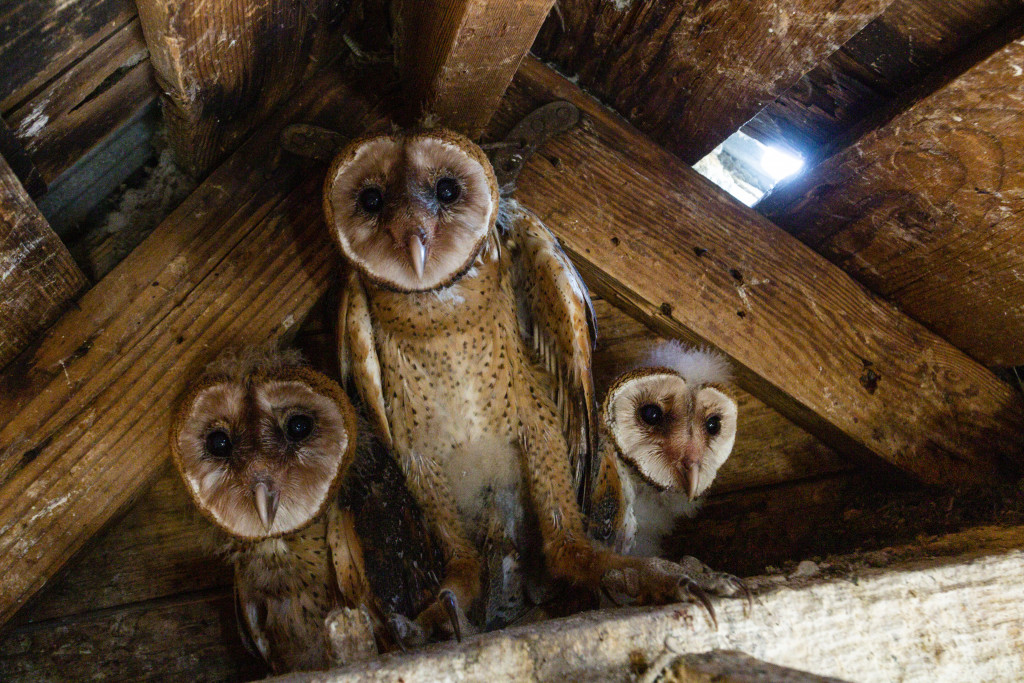
By Julie Geiser
Nebraska Game and Parks district offices get many calls about wildlife. The call I received about stranded baby barn owls was no exception.
A rural family was getting ready to tear down a dilapidated barn on their property when they noticed a baby owl peering over a ledge near the rafters. True stewards of wildlife, they called their local Nebraska Game and Parks office to find out what they could do. Typically, this type of information is forwarded to a volunteer at Raptor Recovery, but at the time, no one was available to respond. Since I had some experience with barn owls, I decided to go.
At the location, I heaved my ladder up to the barn’s mow, or loft, and propped it up against the aging and collapsing barn wall. I could see the young owlet as I made my way up the rungs, and when I reached the top, I was surprised to find three owlets peering back at me. Getting the owlets down was fairly easy, but also loud; the noise they made when scared or alarmed was one that those observing me rescuing the owls will not soon forget. These owls didn’t have all the appropriate feathers that they needed to fly, and it would be another three to four weeks before they were fully fledged and able to fend for themselves.
When threatened, barn owls will go on their backs and protect themselves by clamping down on their perceived predator with sharp talons. That’s exactly what they did to my heavy-duty leather gloves as I reached for them, one at a time. Once they clamped down, I carefully picked them up and covered their wings so they wouldn’t try to fly, which could injure them while being transported. Carrying them down the ladder was fairly easy, but I still needed to pay attention to their sharp beaks.
Once secured in an enclosed box, I needed to figure out what to do with the owlets. Sometimes placing the young owls near their hatching site where the parents will hear them call for food can be successful. Near the barn was a grain bin with several openings for parent birds to gain access to the owlets, while giving the baby owls protection from predators such as raccoons or foxes. If the adult birds could find their young, this would be the first option to try.
But after two days, there were no signs of any mice being brought to the youngsters by their parents, as barn owls will often stockpile mice to feed their young. The owlets didn’t cast any pellets, which was another indication that they had not been fed. The landowners were also keeping an eye out for the adult birds, but no sightings were made.
The young owls’ next journey would be to the Raptor Recovery Center in Elmwood, a move that would depend on a relay of devoted volunteers who could transport them to the center. But until they could be taken, they needed human care so they wouldn’t get dehydrated or hungry. Luckily, I had access to some game meat in my freezer.
However, the owlets wouldn’t eat the food I placed in their cage, so force-feeding was the next step. While one would typically give owls food with hair or feathers, since this is how they would eat food in the wild, I didn’t have that luxury at the time.
Instead, I put food in their mouths when they opened them; once they figured out they were getting food, they cooperated and were eager to feed. Adult owls eat around two mice a night, and owlets usually eat as many as five mice in a single night to help them grow. This kept them alive until they could be taken to the Raptor Recovery Center.
There, the owlets were matched with a surrogate male barn owl that fed and cared for them. Nimbus was an owl that couldn’t be released back into the wild, so he became an educational bird and surrogate. Dead mice were provided in the pen to Nimbus, and he in turn answered the calls of the hungry young owls and took the mice to them. The owlets imprinted on him so there was little human interaction with the birds.
Once the owlets were fully fledged, or feathered, and could fly, they were placed in a flight pen where they learned to hunt on their own like they would have in nature. Mice were placed in a large stock tank with leaves, litter and weeds so the owls could learn to search and catch their food. After learning these skills, they were ready to be released back into the wild.
In August, I received a call from Rachelle Allbery-McQuade, a Raptor Recovery volunteer, who told me that she was releasing the owls that day. She had gotten permission to let the owls go near a barn a few miles from where they hatched so they could find protection from weather and predators.
I couldn’t believe how beautiful these once-scraggly owlets that I rescued had become. Their feathers had all come in, and they had put on weight and were ready to start life on their own. As Rachelle let the birds go, I felt a little sad knowing that I might not see them again, but knew in my heart that they had a great chance at a life in nature where they belong.
Owl pellets are cast through the mouth of an owl and other birds of prey. The pellets are simply the remains of undigested food, such as the hair and bones of rodents or feathers and bones of small birds. Pellets resemble a hairball and, for the curious, can be fun to dissect to see what the owls have been eating. Voles, shrews, field mice and other rodents make up the majority of an owl’s diet.
